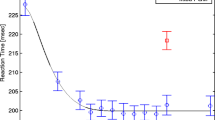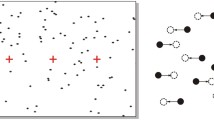Abstract
If the discriminal distributions of signal-detectability theory evolve in time according to a normal Markov process, they can be characterized by Brownian motion generalized with a constant bias determined by signal strength. If the process is stopped at the first occurrence of a preset criterion displacement, the resulting latency distribution provides a model for the central component of simple reaction time. Discussed are properties of the distribution which should be useful in obtaining experimental predictions from neural-counting assumptions, and in relating reaction times to basic variables of the theory of signal-detectability.
Similar content being viewed by others
References
Christie, L. S., & Luce, R. D. Decision structure and time relations in simple choice behavior.Bulletin of Mathematical Biophysics, 1956,18,89–112.
Cox, D. R., & Miller, H. D.The theory of stochastic processes. New York: Wiley, 1965.
Creelman, C. D. Human discrimination of auditory duration.Journal of the Acoustical Society of America, 1961,34, 582–593.
Falmagne, J. C. Stochastic models of choice reaction time with applications to experimental results.Journal of Mathematical Psychology, 1965,2, 77–124.
Feller, W.An introduction to probability theory and its applications, Vol. I. New York: Wiley, 1950.
Feller, W.An introduction to probability theory and its applications, Vol. II. New York: Wiley, 1966.
Granit, R.Receptors and sensory perception. New Haven: Yale University Press, 1955.
Green, D. M., Birdsall, T. G., & Tanner, W. P., Jr. Signal detection as a function of signal intensity and duration.Journal of the Acoustical Society of America, 1957,29, 523–531.
Hohle, R. H. Inferred components of reaction times as functions of fore-period duration.Journal of Experimental Psychology, 1965,69, 382–386.
Lit, A. The magnitude of the Pulfrich stereophenomenon as a function of binocular differences of intensity at various levels of illumination.American Journal of Psychology, 1949,62, 159–181.
McGill, W. J. Stochastic latency mechanisms. In R. D. Luce, R. R. Bush, and E. Galanter (Eds.),Handbook of mathematical psychology, Vol. I. New York: Wiley, 1963, Pp. 309–360.
McGill, W. J. Neural counting mechanisms and energy detection in audition.Journal of Mathematical Psychology, 1967,4, 351–376.
Pieron, H. Nouvelles recherches sur l'analyse du temps de latence sensorielle et sur la loi qui relie ce temps à l'intensitē de l'excitation.Année Psychologie, 1920,22, 58–142.
Selin, I. The sequential estimation and detection of signals in normal noise II.Information and Control, 1965,8, 1–35.
Stone, M. Models of choice reaction time.Psychometrika, 1960,25, 251–260.Review, 1961,68, 301–340.
Swets, J. A., Tanner, W. P., & Birdsall, T. G. Decision processes in perception.Psychological Review, 1961,68, 301–340.
Takacs, L.Combinatorial methods in the theory of stochastic processes. New York: Wiley, 1967.
Taylor, D. H. Latency models for reaction time distributions.Psychometrika, 1965,30, 157–163.
Viterbi, A. J. The effect of sequential decision feedback on communication over the Gaussian channel.Information and Control, 1965,8, 80–92.
Wald, A.Sequential analysis. New York: Wiley, 1947.
Welford, A. T. The measurement of sensory-motor performance: Survey and reappraisal of twelve years' progress.Ergonomics, 1960,3, 189–230.
Author information
Authors and Affiliations
Additional information
This paper was written while the author was on a post-doctoral fellowship at the Mental Health Research Institute, University of Michigan, supported by U.S.P.H.S. Training grant T01-MH-7417-07.
Rights and permissions
About this article
Cite this article
Emerson, P.L. Simple reaction time with markovian evolution of gaussian discriminal processes. Psychometrika 35, 99–109 (1970). https://doi.org/10.1007/BF02290596
Received:
Revised:
Published:
Issue Date:
DOI: https://doi.org/10.1007/BF02290596




